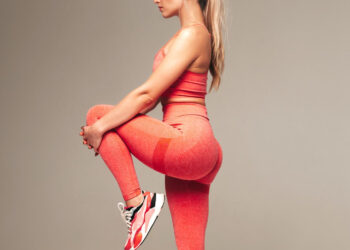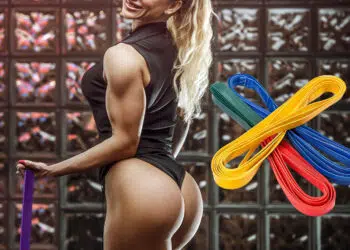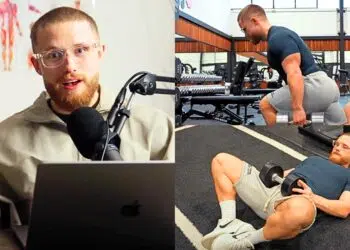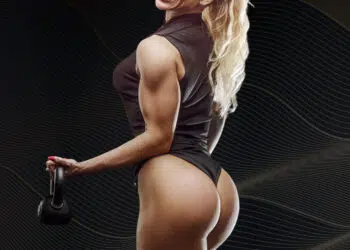In today’s digital age, a quick scroll through Instagram might lead you to believe everyone’s flaunting a picture-perfect booty. But let’s face facts — we’re living in what could rightly be termed an ‘ass-less era.’ For many, behind those filtered photos lies a reality of flat, underdeveloped glutes. And some of those seemingly rounded rears? More fat and fluff than firmness.
Why this deficiency in the derrière department? Our chair-bound lives are primarily to blame. Hours upon hours of sitting not only neglects the glutes but stretches and weakens them. This prolonged inactivity paves the way to hypotonicity, causing our butts to lose that much-desired tone.
As a personal trainer with over 35 years of experience, I’ve helped countless people bid adieu to flabby flatness and reignite their glutes to their powerful potential. Ready to embark on this transformative journey? Read on as I present the crème de la crème of glute exercises tailored for a toned, tight, and truly terrific tush.
Recent Updates: On July 18, 2024, Fitness Volt’s Contributing Editor Andrew Peloquin (NFPT-CPT) and Senior Editor Vidur Saini (American Council on Exercise-CPT) updated the article and added actionable expert tips throughout the piece to improve the reader experience.
Level Up Your Fitness: Join our 💪 strong community in Fitness Volt Newsletter. Get daily inspiration, expert-backed workouts, nutrition tips, the latest in strength sports, and the support you need to reach your goals. Subscribe for free!
15 Best Glutes Exercises
Don’t waste your time on second-rate exercises. Instead, build your best glutes ever with the best exercises! Include at least a few of these exercises in your lower body workouts to sculpt the ultimate butt.
- Barbell Back Squat
- Deadlift
- Belt Squat
- Sumo Deadlift
- Walking Lunge
- Cable Glute Kickback
- Single-Leg Romanian Deadlift
- Hip Thrusts
- Bulgarian Split Squat
- Good Mornings
- Total Hip Machine Hip Extensions
- Clamshells Against a Wall
- Reverse Hyperextensions
- Kettlebell Swing
- Goblet Squat
1. Barbell Back Squat
| Sets & Reps | 3-5 x 5-8 (Strength) / 3-4 x 8-12 (Hypertrophy) |
| Equipment Needed | Barbell, Squat Rack, Weight Plates (Optional: Belt) |
| Target Muscles | Quadriceps, Glutes, Hamstrings, Adductors, Erectors, Core |
The barbell back squat is often thought of as a quadriceps exercise. While that is definitely the case, it’s also a great glute mass exercise too. Make it even more so by wearing a booty band around your knees the next time you do squats.
Saini recommends going as deep as possible on the eccentric phase to maximize glute fiber stimulation and growth.
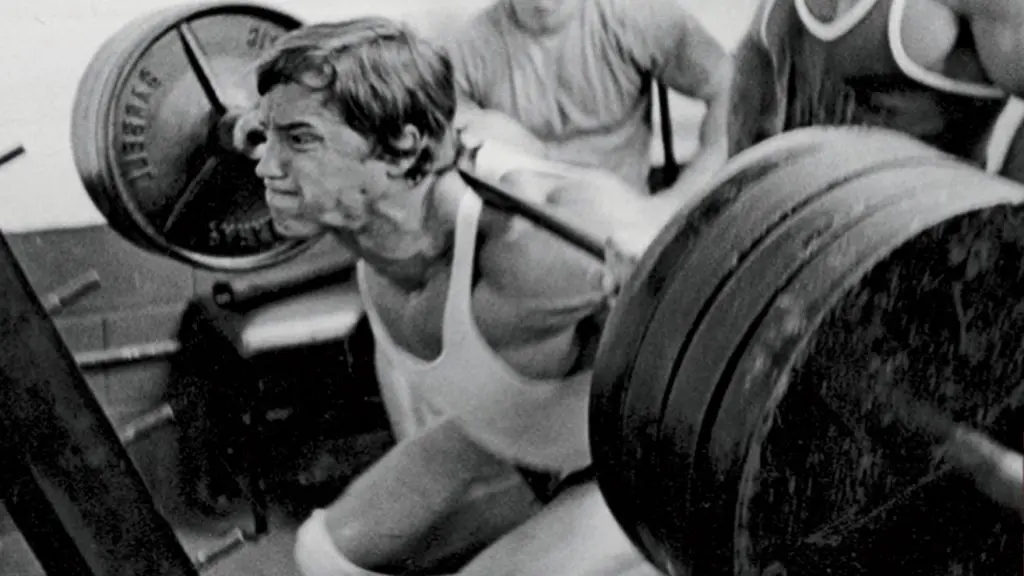
How to do it:
- Rest and hold a barbell across your upper back. Step out and into a shoulder-width stance, with your feet turned slightly outward. If using a booty band, make sure you push your knees outward against the material. Brace your abs and lift your chest.
- Push your hips back, bend your knees, and descend until your thighs are roughly parallel to the floor. Do not round your lower back. Make sure you keep your weight on your heels.
- Stand back up and repeat.
Pro Tip: For greater glute activation, wear a booty band around your knees and ensure you push your knees outward against the material.
Benefits:
- A very functional exercise
- A great total lower body move
- Useful for building muscle mass and strength
| Difficulty | Progression | Regression |
| Intermediate | Pause squats, front squats, box squats | Goblet squats, bodyweight squats, box squats (high) |
2. Deadlift
| Sets & Reps | 3-5 x 3-5 (Strength) / 3-4 x 6-10 (Hypertrophy) |
| Equipment Needed | Barbell, Weight Plates (Optional: Belt, Straps) |
| Target Muscles | Glutes, Hamstrings, Erectors, Trapezius, Forearms, Core |
The conventional deadlift stands out as the monarch amongst deadlift variations. This time-honored exercise earns its high reputation by intensely engaging the muscles spanning the hip, knee, and ankle regions.
Furthermore, gripping the barbell demands strength from muscles around the wrist, elbow, and shoulder, even though these joints don’t contribute to the movement’s range of motion.
It predominantly targets hip extension and seamlessly integrates into back or leg training sessions. Few exercises can match the conventional deadlift’s prowess when it comes to generating sheer mechanical tension on the posterior.

How to Do It:
- Start with a hip-width stance, hinge forward at the hips, push your buttocks back, and reach down for the barbell.
- Grip the bar slightly wider than your shins.
- Ensure a straight back, lift your chest, and inhale deeply.
- Drive through your heels, lifting the bar off the ground.
- Once the bar ascends past your knees, powerfully push your hips forward and clench your glutes to stand tall.
Pro Tip: Dedicate some sessions to refine your initial position, aiming for maximum glute activation.
Benefits:
- Enhances hip extension strength.
- Contributes to overall posterior chain development.
- Enhances grip strength.
- Offers functional strength benefits that translate to daily activities.
| Difficulty | Progression | Regression |
| Intermediate | Deficit deadlifts | Rack pulls, trap bar deadlifts, kettlebell swings |
3. Belt Squat
| Sets & Reps | 3-4 x 8-12 (Strength & Hypertrophy) |
| Equipment Needed | Belt Squat Machine, Weight Plates |
| Target Muscles | Quadriceps, Glutes, Hamstrings, Adductors |
An exceptional squat variation that uses a machine to prioritize the lower body, removing strain from the lower back and spine. Ideal for individuals across various fitness spectrums aiming for robust quads and glutes.
“Drive your hips forward as you stand up, rather than just straightening your legs, to maximize glute activation and minimize knee stress,” cues Saini.
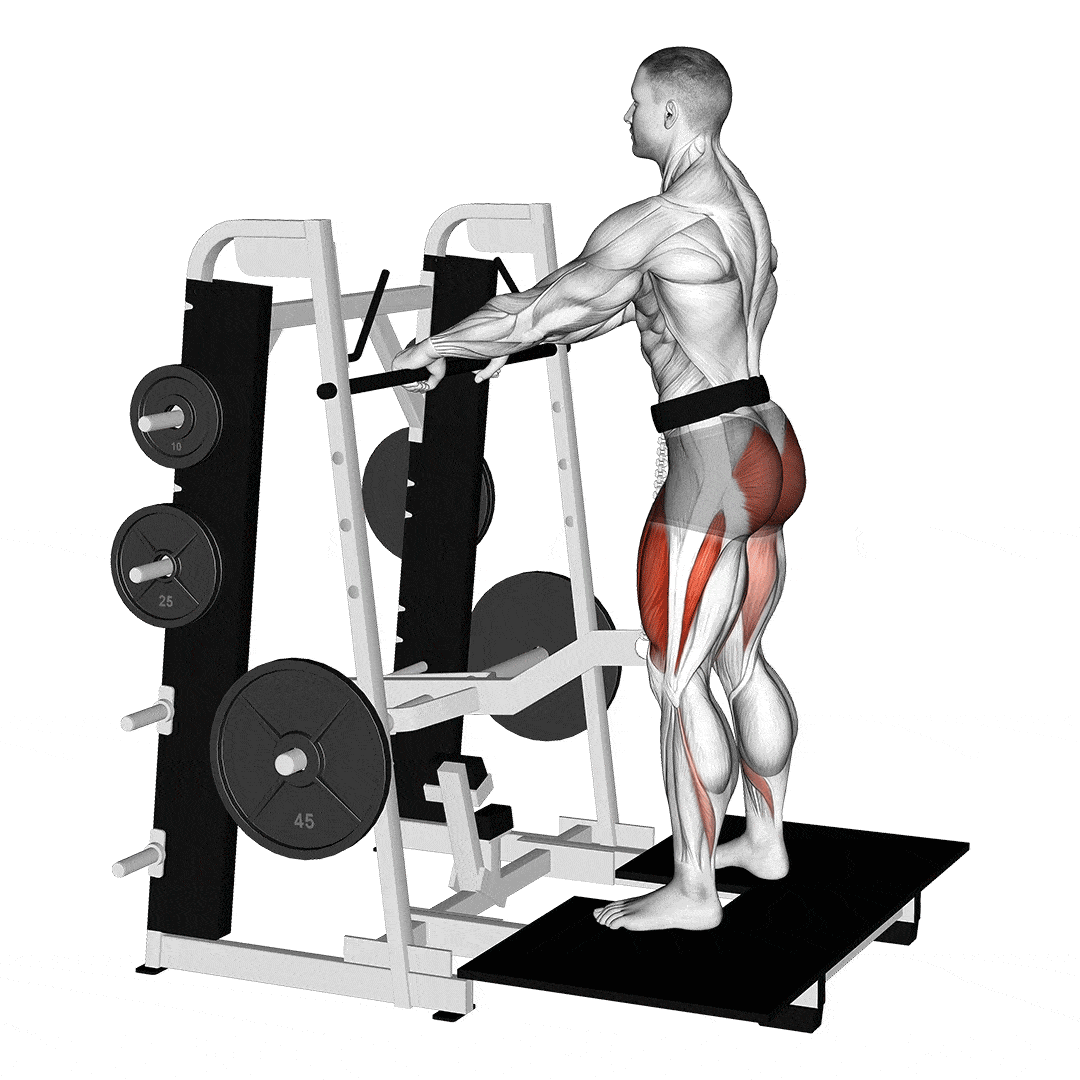
How to Do It:
- Stand on the platform, securing the belt around your hips.
- Position your feet on either side of the platform pulley and grasp the handles in front.
- Engage the pulley, find your balance, and take a deep breath.
- Descend in a squatting motion, letting the pulley guide you.
- Return to the standing position.
Pro Tip: Visualize the pulley drawing your hips directly into the squat’s depth.
Benefits:
- It promotes a more vertical spine, reducing the load on the lower back.
- This allows for enhanced training volume without added strain, as the weight is directed toward the hips instead of pressing on the torso.
| Difficulty | Progression | Regression |
| Intermediate | Tempo reps | Bodyweight squats |
4. Sumo Deadlift
| Sets & Reps | 3-5 x 3-5 (Strength) / 3-4 x 6-10 (Hypertrophy) |
| Equipment Needed | Barbell, Weight Plates (Optional: Belt, Straps) |
| Target Muscles | Glutes, Hamstrings, Adductors, Quadriceps, Erectors, Trapezius, Forearms, Core |
A popular deadlift variation that emphasizes a wide stance and targets the lower body, it’s ideal for those looking to boost strength and sculpt their glutes.
Saini highlights that sumo deadlifts can be advantageous for individuals with longer legs or those who struggle to maintain a neutral spine during conventional deadlifts.

How to Do It:
- Approach a loaded barbell and assume a wide, outward-facing foot stance.
- Hinge at the hips, descending to grip the bar.
- With a braced core, push your knees out while elevating your chest.
- Engage your legs, pushing off the ground and standing up to complete the motion.
Pro Tip: The sumo deadlift lacks an eccentric phase; maintain grip, but let the bar descend freely between repetitions.
Benefits:
- Engages the hips in external rotation, emphasizing the glute medius and minimus.
- Allows a more upright torso, reducing lumbar spine load.
- Celebrated for its effectiveness in strength competitions and aesthetics.
| Difficulty | Progression | Regression |
| Intermediate | Deficit sumo deadlifts, Romanian deadlifts | Trap bar deadlifts, kettlebell swings |
5. Walking Lunge
| Sets & Reps | 3-4 x 10-15 per leg (Strength & Hypertrophy) |
| Equipment Needed | (Optional: Dumbbells, Barbell) |
| Target Muscles | Quadriceps, Glutes, Hamstrings |
A dynamic lunge variant where stepping forward is integral, offering a balanced blend of muscular and cardiovascular exertion.
Saini explains that walking lunges challenge your balance and stability, which can improve coordination and athleticism while building single-leg strength.
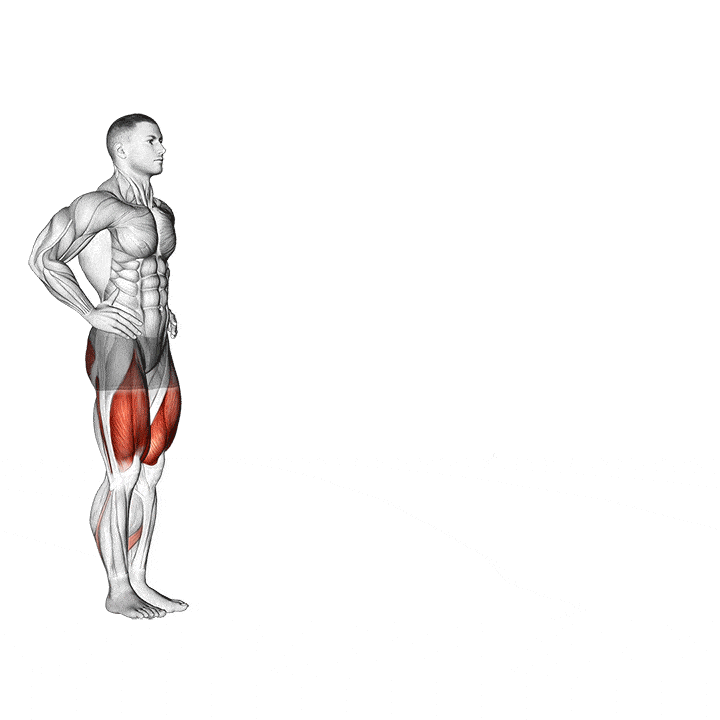
How to Do It:
- Begin with feet together, then step forward, planting your foot.
- Lower your back knee directly downwards, ensuring the front knee aligns with your toes.
- Push off the front foot, bringing the back foot forward to reset.
Pro Tip: Maintain a steady pace; the walking lunge taxes cardiovascular stamina significantly.
Benefits:
- Enhances coordination and balance.
- Offers extensive and dynamic glute activation.
- Versatility in weight options catering to beginners and advanced trainees.
| Difficulty | Progression | Regression |
| Beginner | Increase distance, add weight, reverse lunges | Static lunges, split squats |
6. Cable Glute Kickback
| Sets & Reps | 3-4 x 12-15 per leg (Strength & Hypertrophy) |
| Equipment Needed | Cable Machine, Ankle Cuff |
| Target Muscles | Gluteus Maximus, Gluteus Medius |
An isolative glute exercise employing cables or machines to ensure targeted muscle contraction, ideal as a concluding workout movement.
Saini adds that cable kickbacks allow for constant tension throughout the glute’s range of motion, unlike some exercises that rely on gravity.
How to Do It:
- Attach a strap to the cable machine and fasten it around your ankle.
- With a neutral spine and engaged core, lean forward slightly.
- Extend your leg backward, ensuring a minor knee bend.
- Elevate until the working glute contracts fully, relaxing the non-working leg.
Pro Tip: Maintain a nearly straight knee — avoid locking it out.
Benefits:
- Offers unparalleled gluteal isolation.
- Effective across the entire muscular contractile range.
- Adaptable for targeting either the glute medius or maximus.
| Difficulty | Progression | Regression |
| Beginner | Single-leg kickbacks, hip thrusts | Standing hip extensions, clamshells |
7. Single-Leg Romanian Deadlift
| Sets & Reps | 3-4 x 8-12 per leg (Strength & Hypertrophy) |
| Equipment Needed | (Optional: Dumbbell, Kettlebell) |
| Target Muscles | Glutes, Hamstrings, Erectors, Core |
Using one leg, this exercise works not only the gluteus maximus but also the medius, minimus, and TFL.
Saini underlines that single-leg RDLs are an excellent tool for identifying and correcting muscle imbalances between your legs, leading to improved symmetry and function.
How to Do It:
- Hold a dumbbell in each hand or a kettlebell in both. Stand with your feet together, knees slightly bent but rigid. Shift your weight over onto one leg.
- Hinge from your hips and lean forward, lowering the weight(s) down the front of your leg as far as you can without rounding your lower back. Extend your non-working leg out behind you for balance.
- Stand back up and repeat.
- Do the same number of reps on each leg.
Pro Tip: Keep a slight bend in your standing knee and maintain balance throughout the movement.
Benefits:
- Less low back stress than regular Romanian deadlifts
- Good for developing your balance
- An excellent exercise for athletes
| Difficulty | Progression | Regression |
| Intermediate | Deficit RDLs | Hip hinges |
8. Hip Thrusts
| Sets & Reps | 3-4 x 8-12 (Strength & Hypertrophy) |
| Equipment Needed | Barbell, Bench, Weight Plates, Pad (optional) |
| Target Muscles | Gluteus Maximus, Hamstrings |
While you can do hip thrusts lying on the floor, it’s a much more effective exercise when done with raised shoulders. Why? Because it increases your range of motion, and that increases the difficulty of this exercise.
Saini suggests using a barbell pad for this exercise, as it keeps the bar from digging into the pelvic bone.
How to Do It:
- Sit on the floor so your upper back rests against a sturdy exercise bench. Bend your legs and place your feet flat. Rest and hold a barbell across your hips.
- Contract your glutes and push your hips up toward the ceiling. At the top of the rep, your knees, hips, and shoulders should form a straight line.
- Lower your butt back down to the floor and repeat.
- No weights? No problem! You can do this exercise with one leg to compensate for any lack of resistance.
- Add a booty band to make this exercise more glute-centric
Pro Tip: Ensure full hip extension at the top without hyperextending your lower back.
Benefits:
- Minimal low back stress
- Produces an intense contraction at the top of each rep
- Can be done with or without weights
| Difficulty | Progression | Regression |
| Intermediate | Single-leg hip thrusts, band resistance | Glute bridge |
9. Bulgarian Split Squat
| Sets & Reps | 3-4 x 8-12 per leg (Strength & Hypertrophy) |
| Equipment Needed | (Optional: Dumbbells, Barbell) |
| Target Muscles | Quadriceps, Glutes, Hamstrings |
This is another exercise that is often thought of as “just” a thigh exercise when, in actuality, it’s a great glute move, too. Using one leg at a time is ideal for training gluteus minimus, medius, TFL, and glute max.
Bulgarian split squats help build unilateral leg strength, which is crucial for injury prevention and performance enhancement, says Saini.
How to Do It:
- Stand with your back to a knee-high exercise bench. Bend one leg and place the top of your foot on the bench behind you. Hop forward and into a split stance.
- Bend your legs and lower your rear knee down to within an inch or so of the floor. Lean forward slightly from your hips to maximize glute activation.
- Stand back up and repeat.
- Do the same number of reps on each leg.
- Hold dumbbells by your sides, a barbell across your upper back, or a kettlebell in front of your chest to make this exercise harder.
- You can also do this move with your rear foot in a suspension trainer.
Pro Tip: Maintain an upright posture and ensure your knee doesn’t travel too far past your toes.
Benefits:
- An excellent exercise for improving balance
- Good for hip mobility
- A useful exercise for athletes, and especially runner.
| Difficulty | Progression | Regression |
| Intermediate | Front foot elevated split squats | Reverse lunges, split squats |
10. Good Mornings
| Sets & Reps | 3-5 x 5-8 (Strength) / 3-4 x 8-12 (Hypertrophy) |
| Equipment Needed | Barbell, Squat Rack |
| Target Muscles | Glutes, Hamstrings, Erectors |
Good mornings are a somewhat controversial exercise because some trainers think they are bad for your lower back. If you round your lower back, this move could definitely cause injury but, done right, it’s not really much riskier than Romanian deadlifts.
Saini underlines that Good mornings are a humbling exercise that teaches you to brace your core and maintain a neutral spine under load, which is vital for preventing back injuries.
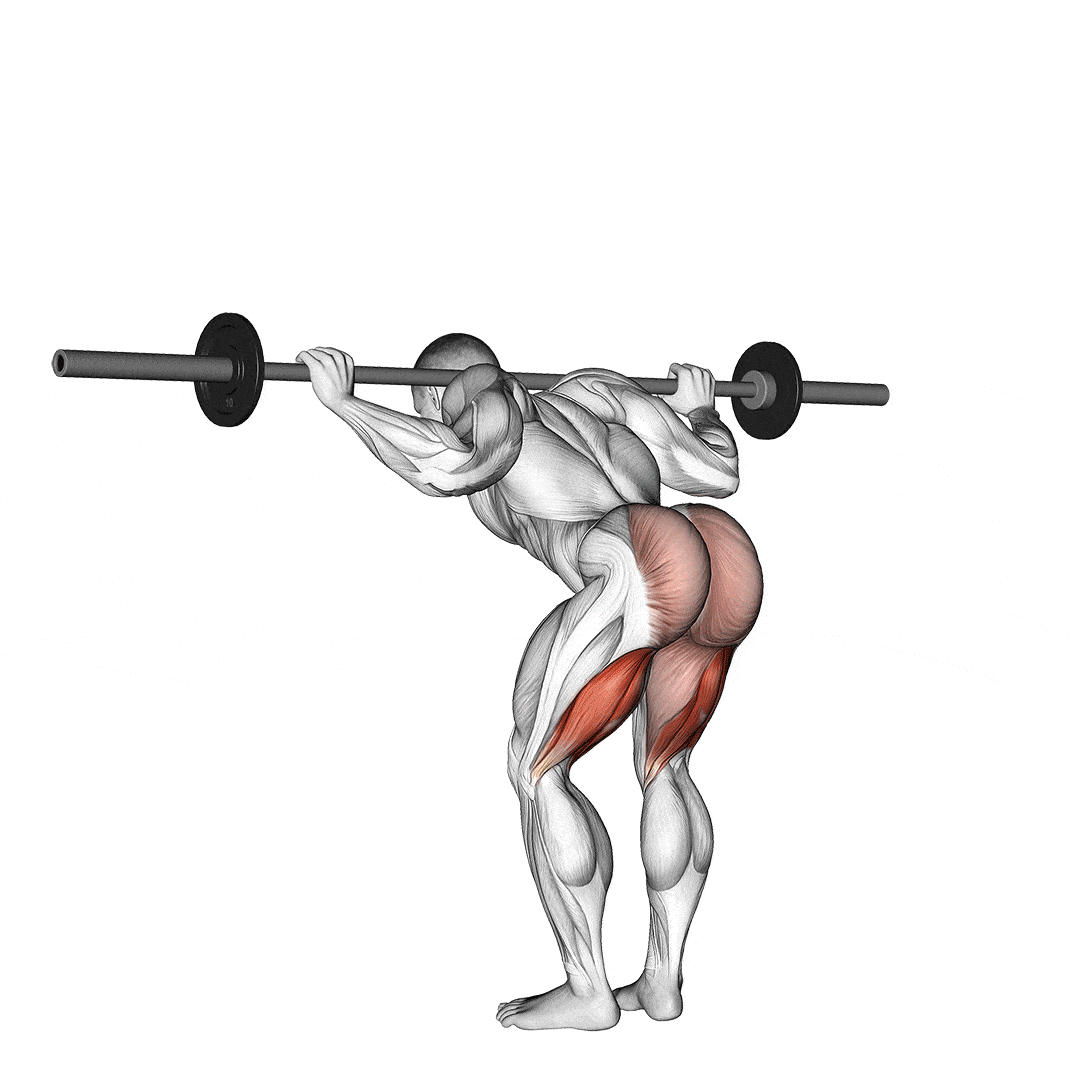
How to Do It:
- Rest and hold a barbell across your upper back as though you were going to do squats. Stand with your feet about hip-width apart. Bend your knees slightly, but then keep them rigid. Brace your core and lift your chest.
- Hinge from your hips and bend forward as far as you can without rounding your lower back. Feel a deep stretch in your hamstrings.
- Stand back up and repeat.
- You can also do this exercise with the bar in the crook of your elbows – a Zercher good morning.
Pro Tip: Ensure you don’t approach failure; it’s challenging to safely release the weight.
Benefits:
- Useful for developing a powerful hip hinge
- An effective strength and muscle mass exercise
- Very little grip strength required
| Difficulty | Progression | Regression |
| Advanced | Paused reps | Romanian deadlifts, hip thrusts |
11. Total Hip Machine Hip Extensions
| Sets & Reps | 3-4 x 10-15 (Strength & Hypertrophy) |
| Equipment Needed | Total Hip Machine |
| Target Muscles | Gluteus Maximus, Hamstrings |
With no weights in your hands or on your back, this exercise is a stress-free way to build glute mass. You can also adjust the range of motion to suit your flexibility. Most gyms have a total hip machine.
Hip extension machines isolate the glutes and hamstrings, making them a valuable tool for targeting these muscles when free weights aren’t feasible, explains Saini.
Level Up Your Fitness: Join our 💪 strong community in Fitness Volt Newsletter. Get daily inspiration, expert-backed workouts, nutrition tips, the latest in strength sports, and the support you need to reach your goals. Subscribe for free!
How to Do It:
- Adjust the lever arm so that the leg pad is about hip height. Standing side on to the machine, lift and place the crook of your knee over the leg pad. Bend your supporting leg slightly for balance and grab the handles.
- Drive your thigh down and back against the resistance offered by the machine. Extend your hip fully but without hyperextending your lower back.
- Return to the starting position and repeat.
- Do the same number of reps on each leg.
Pro Tip: Focus on squeezing the glutes at the peak of the movement and ensure no hyperextension of the lower back.
Benefits:
- No spinal compression
- A functional, full-range exercise
- An excellent way to ensure both sides are trained equally.
| Difficulty | Progression | Regression |
| Beginner | Increase weight | Standing hip extensions, clamshells |
12. Clamshells Against a Wall
| Sets & Reps | 3-4 x 15-20 per leg (Strength & Hypertrophy) |
| Equipment Needed | Wall (Optional: Resistance Band) |
| Target Muscles | Gluteus Medius, Gluteus Minimus |
This exercise involves external hip rotation, which emphasizes the gluteus minimus and medius. If you have problems with your knees falling in when you squat, lunge, or run, this exercise could be the solution.
Saini adds that clamshells strengthen the often-neglected gluteus medius, a key hip stabilizer that helps prevent knee pain and improve athletic performance.
How to Do It:
- Lie on your side with your back against a wall. Bend your legs and place your feet flat against the wall too. Rest your head on your outstretched arm.
- Without moving your pelvis, open your legs and lift your uppermost knee up and out toward the wall. Your range of motion will depend on your flexibility.
- Lower your leg and repeat.
- Try to do the same number of reps on each leg.
- This exercise can also be done without the wall, but you’ll have to really focus on keeping your hips square.
Pro Tip: Keep hips square and focus on external hip rotation without moving the pelvis.
Benefits:
- No lower back stress
- A good exercise for hip stability
- A prehab-rehab exercise for getting your glutes firing properly
| Difficulty | Progression | Regression |
| Beginner | Add resistance band, side planks | Side walks |
13. Reverse Hyperextensions
| Sets & Reps | 3-4 x 12-15 (Strength & Hypertrophy) |
| Equipment Needed | Reverse Hyperextension Machine or Bench |
| Target Muscles | Glutes, Hamstrings, Erectors |
Most hip extension exercises involve lifting your upper body. This can, in some cases, put a lot of stress on your lower back. With reverse hyperextensions, your upper body remains stationary while your legs move. This is easier on your lower back but still provides an effective glute workout.
Reverse hypers are a low-impact way to strengthen the posterior chain muscles, which are crucial for posture and hip extension power, explains Saini.
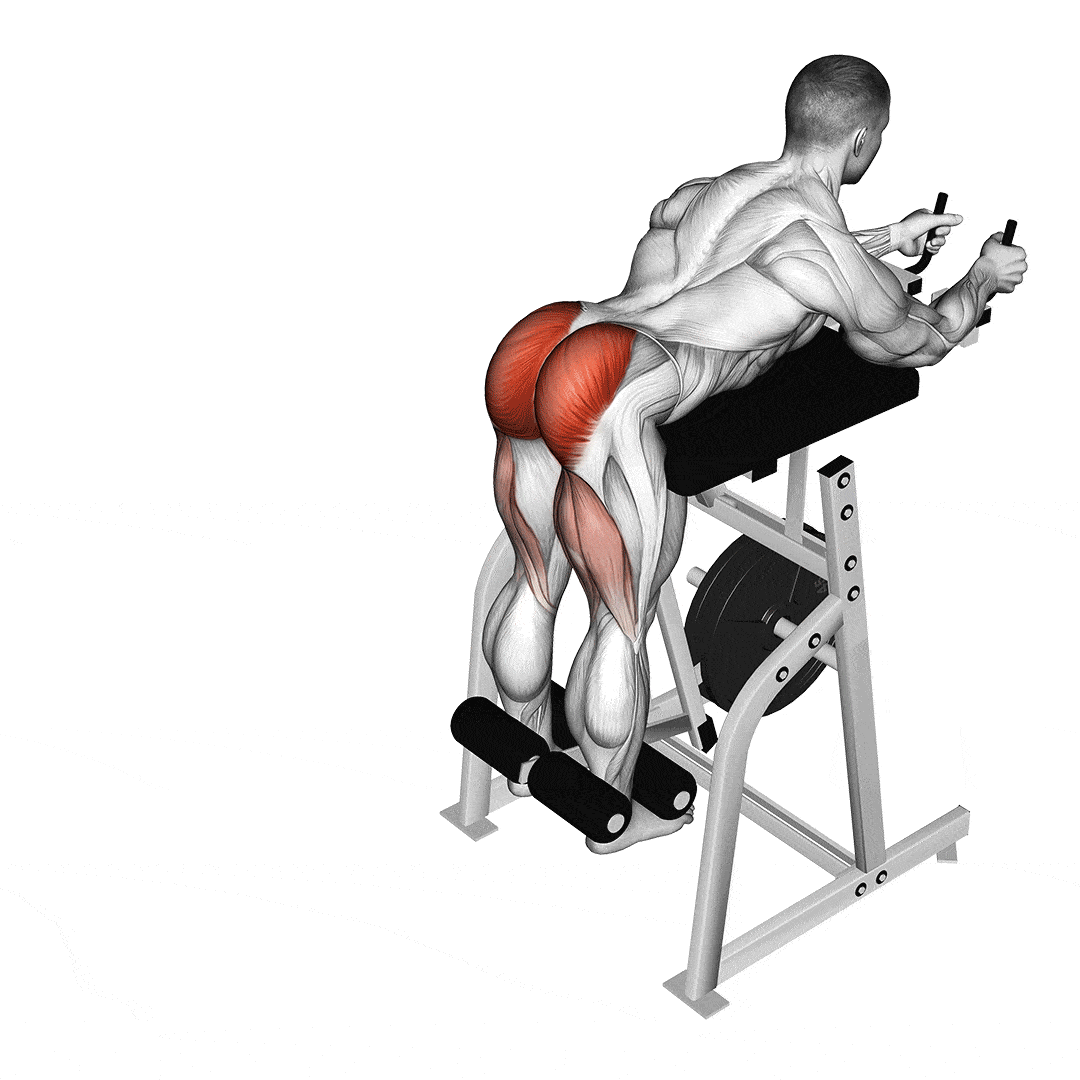
How to Do It:
- Lie face down on a hyperextension bench. Your hips should be on the edge of the bench, in line with the pivot point. Attach the loading strap to your ankles and grab the handles.
- With your knees slightly bent, extend your hips and lift your legs up behind you until they are roughly parallel to the floor.
- Lower your legs and repeat.
- Adjust the weight to match your current level of strength.
Pro Tip: Ensure only the legs are moving and the upper body remains stationary.
Benefits:
- Minimal lower back stress
- Works the glutes and hamstrings together
- Can also be done using a bench and a stability ball if required
| Difficulty | Progression | Regression |
| Intermediate | Tempo reps | Glute bridge, hip thrusts with raised shoulders |
14. Kettlebell Swing
| Sets & Reps | 3-4 x 10-15 (Strength & Hypertrophy) |
| Equipment Needed | Kettlebell |
| Target Muscles | Glutes, Hamstrings, Erectors, Shoulders, Core |
The kettlebell swing is a dynamic movement that combines strength and conditioning. This explosive exercise propels you into a hinge position and requires a strong hip thrust, making it ideal for rapid glute activation while also offering cardiovascular benefits.
Saini highlights that kettlebell swings build explosive hip extension power, translating to faster sprinting, higher jumps, and stronger lifts.
How to Do It:
- Position yourself with a kettlebell between your feet, slightly wider than shoulder-width apart.
- Hinge down to grab the kettlebell, swinging it back between your legs before thrusting your hips forward powerfully.
- Allow the kettlebell to rise naturally to belly button height or a bit higher, then let it fall back down, initiating the next swing.
Pro Tip: Keep the arms relaxed; the motion should come from the hips, not the arms.
Benefits:
- Enhances explosive power in the hips.
- Provides cardiovascular benefits along with strength training.
- Can be used for conditioning, active recovery, or muscle-building.
| Difficulty | Progression | Regression |
| Intermediate | American kettlebell swing | Single-arm kettlebell swing |
15. Goblet Squat
| Sets & Reps | 3-4 x 8-12 (Strength & Hypertrophy) |
| Equipment Needed | Dumbbell or Kettlebell |
| Target Muscles | Quadriceps, Glutes, Hamstrings, Core |
The goblet squat, a front-loaded squat variation, assists lifters in maintaining an upright posture. Using either dumbbells or kettlebells, it’s beginner-friendly and acts as a bridge from bodyweight to weighted squats, introducing lifters to more advanced squat variations.
Saini prescribes goblet squats, a beginner-friendly exercise that teaches proper squat mechanics while building lower body strength and mobility.
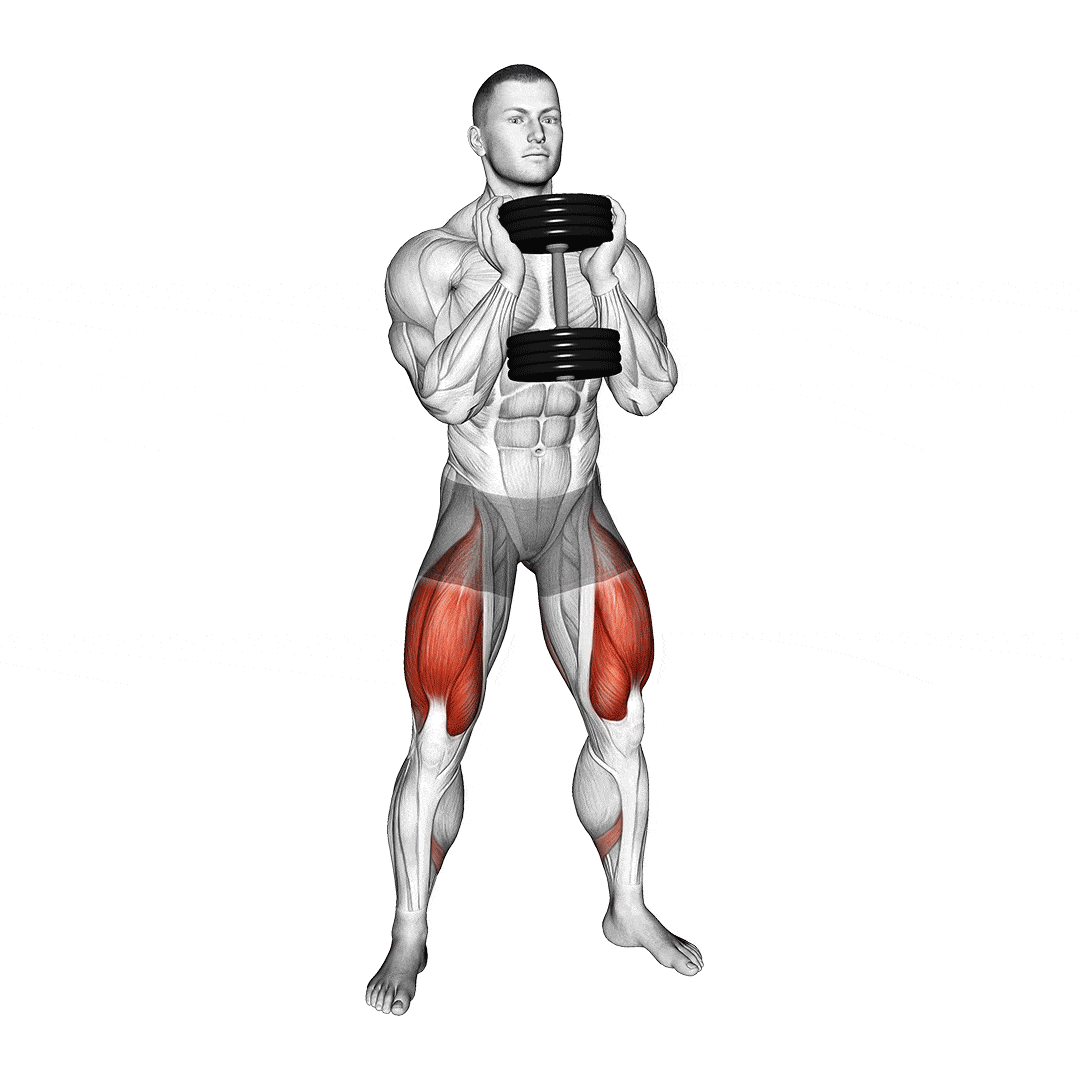
How to Do It:
- Stand with feet shoulder-width apart, holding a weight just under your chin, elbows tucked.
- Keep your chest up, squat until your thighs are parallel to the ground, then push through the heels to return up.
Pro Tip: Maintain an active hold on the weight, avoiding resting it on the chest.
Benefits:
- Promotes proper squat posture.
- Suitable for beginners and advanced trainees.
- Versatile for leg muscle development and endurance.
| Difficulty | Progression | Regression |
| Beginner | Front barbell squats, Bulgarian split squats | Bodyweight squats |
Best Glute Workout For Overall Development
The following glute workout incorporates a mix of compound and isolation movements for balanced strength and hypertrophy:
| Exercise | Sets | Reps | Rest |
| Barbell Back Squat | 3 | 8-12 | 60-90 sec |
| Hip Thrusts with Raised Shoulders | 3 | 8-12 | 60-90 sec |
| Walking Lunge | 3 | 10-15/leg | 60 sec |
| Single Leg Romanian Deadlift | 3 | 8-12/leg | 60 sec |
| Cable Glute Kickback | 3 | 12-15/leg | 45 sec |
Glutes Warm-Up
Before you deep dive into glute sculpting, invest some quality time in essential mobility drills. Proper glute exercises, especially when done with precision and perhaps with resistance bands, are not a cakewalk.
The gold standard for warming up any muscle group lies in the very exercises that your training day encompasses. Say, you’re tackling back squats – initiate with light repetitions and gradually ramp up the intensity as you transition to your main sets.
This strategy ensures prime readiness of the necessary muscles and joints, mitigates injury risks, and amplifies your training prowess. Consider this warm-up routine for your subsequent glute-intensive workout:
- 5-10 minutes of cardio: incline treadmill, stair-stepper, or elliptical.
- 2 sets of 15-20: banded side shuffles, unweighted step-ups, or bridges.
- 1-2 sets of your premier compound exercise using a bare bar or featherlight dumbbells.
Glute Training Tips
Get more from your glute training with these crucial and helpful workout tips.
Don’t overemphasize hip extension
Hip extension IS an important glute function, but it’s one of several movements that your glutes are responsible for. To develop your glutes to their fullest, make sure you include exercises that involve hip abduction and lateral rotation as well as extension.
In some cases, all three of these movements can be combined into one exercise, for example, by wearing a booty band during hip thrusts and squats.
Use a full range of motion
Some glute exercises involve a very short range of motion, often just the last 45 degrees of hip extension. While these exercises aren’t entirely useless, they are not as useful as those that involve a much bigger range of motion. Choose at least a few exercises that involve moving from full hip flexion to hip extension to work your glutes through their entire range of motion.
This is better for muscular development and developing functional strength, not to mention maintaining or improving flexibility.
Use a broad rep range
Your glutes are made up of fast-twitch and slow-twitch muscle fibers. Fast-twitch fibers respond best to heavy weights and low reps. In contrast, slow-twitch fibers are more aerobic in nature and do better with lighter weights and higher reps.
To maximize glute complex development, make sure you include low rep/heavy weight and higher rep/lower weight training in your workouts.
Watch your lower back
Many of the best glute exercises for mass also involve the lower back. In most cases, the lower back has to act as a stabilizer to prevent unwanted movement of the spine.
Rounding your lower back could lead to injury, so make sure you avoid doing so. Instead, make sure you hinge from your hips instead of moving your back. Not only will this reduce your risk of injury, but it will also make your chosen exercise more effective.
Don’t forget to include some single leg exercises
One of the most effective ways to activate and strengthen your gluteus minimus, medius, and TFL, is to stand and move on one leg. These small but no less important muscles will then have to work extra hard to stabilize your pelvis. If you want to increase hip stability, make sure you include some unilateral exercises in your glute mass workout.
Mastering Glute Training
Incorporating glute-centric exercises into your fitness regime is paramount. However, the extent varies based on your training cycle and proficiency level. Let’s decode glute training essentials.
Volume and Intensity
12 to 16 sets weekly can serve as an ideal base for those eager to enhance their glute muscles. For seasoned fitness enthusiasts, amplifying this could help smash through stagnations.
Select 3-4 exercises from your roster and allocate your sets evenly. Endeavor to maintain equilibrium between hip’s flexion-extension and its internal-external rotation movements.
It’s pivotal to recognize that there’s an upper threshold to how much you can push in a single session without compromising efficiency. If you discern a dip in your performance, consider distributing the workout load over multiple days. Aim for 2-3 training sessions weekly for optimal muscle hypertrophy.
Selecting the Right Exercises
The exercises you cherry-pick critically determine the targeted muscles. Leg muscles collaborate seamlessly to facilitate diverse movement patterns, with distinct muscles taking the lead based on the exercise.
For optimal results, your exercise choices should:
- Apply adequate tension to the muscle without overburdening adjacent joints.
- Ensure resistance aligns with the desired muscle group.
- Cater to personal injuries or restrictions.
- Suit the gear available in your training zone.
Sequencing Your Exercises
It’s not just the ‘what’ and ‘how’; the ‘when’ is equally vital. Compound movements, especially for rookies, should dominate the early parts of your routine. Fatigue often leads to technique deterioration, heightening injury risk.
Kickstart your regimen with energy-intensive exercises like sumo deadlifts and back squats. These compound titans, executed while you’re at your peak, can substantially augment your workout efficacy. Here’s a sample sequence for an upcoming glute-centric session:
- Back Squat
- Glute Bridge
- Walking Lunge
- Cable Glute Kickback
This hierarchy ensures you harness your peak energy for the robust compound lifts and then transition to more focused, isolation drills.
What Muscles Make Up the Glutes
Glutes is usually short for gluteus maximus. However, there are other muscles that make up the glute complex that are no less important.
Providing you use the best glute exercises, you should have no problem building a muscular butt. Still, it’s always useful to know a little about the underlying anatomy of the muscles you want to develop.
And don’t for a moment underestimate the importance of the glutes. They are biomechanically similar to your deltoids or shoulder muscles. In fact, some people call them the deltoids of the hip.
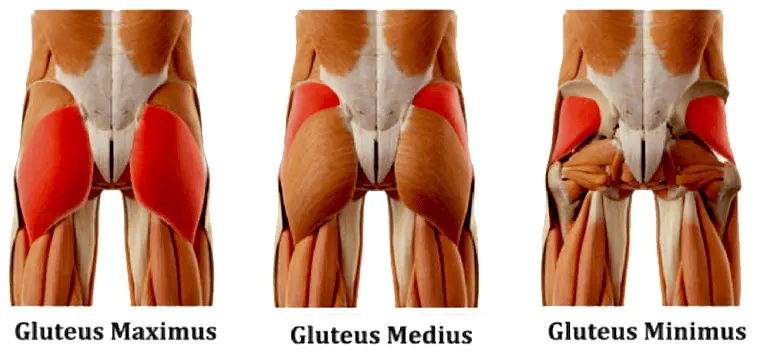
The muscles that make up the glutes complex are:
Gluteus maximus
This is the muscle you are currently sat on, but it’s more than just somewhere convenient to sit! The gluteus maximus is the largest muscle in the human body and also potentially the most powerful. Located on the back and side of your hip, the functions of the gluteus maximus are:
- Hip extension
- Hip lateral (external) rotation
- Hip abduction (superior or upper portion)
- Hip adduction (inferior or lower portion)
Gluteus medius
The gluteus medius is located above and beneath the gluteus maximus near the iliac crest of the pelvis. It works alongside gluteus maximus and also has some additional functions.
- Hip abduction (movement away from midline of body)
- Hip medial (internal) rotation
- Pelvis stabilization
Gluteus minimus
This is a small triangle-shaped muscle located within the posterior aspect of the hip. Like the gluteus medius, gluteus minimus also works alongside the gluteus maximus, and its functions are:
- Hip abduction
- Hip medial rotation
- Pelvis stabilization
Tensor fascia latae
Meaning white tissue, the TFL is part of the glute complex despite not having the word gluteus in its name. It’s a biaxial muscle which means it crosses two joints – the hip and the knee. As part of the glute group, TFL is involved in:
- Hip internal rotation
- Hip abduction
- Pelvis stabilization
Gluteus maximus might be the most prominent muscle in the glute complex, but the other muscles deserve your attention too. They might not contribute much to butt mass, but they are critical for hip stability and performance.
If these other, smaller muscles are neglected, your hips won’t be as stable, and that will affect your athletic performance. Because of the complexity of this part of your body, you must train your glutes from several different directions to ensure you include all of these muscles.
Wrapping Up
Your glutes are one of the most important muscles in your body. Not only do they give your rear an attractive shape, but they are also involved in almost every human movement. From getting out a chair to climbing stairs to walking, running, and jumping, your glutes are the engine that drives you forward and upward.
Your glutes are also crucial for the health of your lower back. When lifting heavy objects off the floor, if your glutes are weak, your back ends up bearing more of the load, and that’s a recipe for injury.
Say “no” to weak, soft, small glutes! Add some mass to your ass with these tried and tested exercises.
References:
- Elzanie, A., & Borger, J. (2022). Anatomy, Bony Pelvis and Lower Limb, Gluteus Maximus Muscle. In StatPearls. StatPearls Publishing.
- Schoenfeld, B. J., Ogborn, D., & Krieger, J. W. (2016). Effects of Resistance Training Frequency on Measures of Muscle Hypertrophy: A Systematic Review and Meta-Analysis. Sports medicine (Auckland, N.Z.), 46(11), 1689–1697.
- Buckthorpe, M., Stride, M., & Villa, F. D. (2019). ASSESSING AND TREATING GLUTEUS MAXIMUS WEAKNESS – A CLINICAL COMMENTARY. International journal of sports physical therapy, 14(4), 655–669.
Interested in measuring your progress? Check out our strength standards for Hip Adduction, Good Morning, Hip Abduction, and more.




